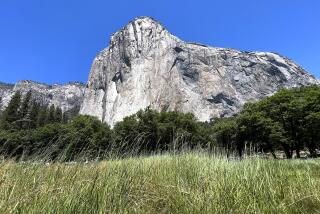Preserving national treasures
- Share via
America’s third national park, Yosemite, the home of spectacular waterfalls, silent groves of ancient trees and an unequaled alpine wilderness, celebrated its 120th birthday this month. The place John Muir considered “nature’s temple” was arguably where the national park idea was born — a uniquely American idea whose enduring meaning is being proved again in the midst of an economic downturn, as millions of families have flocked to Yosemite and other parks to make memories that will last their lifetimes, to reconnect with nature and our shared history.
It is no surprise that our parks have seen record attendance during these tough times. The same thing happened during the Depression, when President Franklin D. Roosevelt made a series of highly publicized park visits and encouraged citizens to do the same. “There is nothing so American as our national parks,” Roosevelt told the nation, and the fundamental idea behind them is “that the country belongs to the people.”
Together, we own some of the most spectacular scenery on Earth — from its grandest canyon to its greatest collection of geysers, from giant sequoias to active volcanoes in the midst of creating new land, from the majestic peak of Alaska’s Denali to the saw grass marsh of Florida’s Everglades.
Our national parks also tell diverse stories and teach valuable lessons about our shared heritage —which include the African American Buffalo Soldiers who once protected Yosemite and the Latino settlers who built the San Antonio Missions in Texas, the beacon of freedom at the Statue of Liberty and the former Japanese internment camp at Manzanar, the hallowed ground of Gettysburg and the newly consecrated field near Shanksville, Pa., where the passengers of Flight 93 died on 9/11.
They belong to all of us. And with that inheritance comes the responsibility to take care of these special — even sacred — places, so that they can provide the same solace and inspiration to our children and our children’s children.
Like Roosevelt, President Obama and his family have visited the parks; and like Roosevelt, who used the Civilian Conservation Corps, Obama has been directing some economic stimulus funding to make much-needed improvements within park borders. Now, after holding a series of listening sessions across the country on what it calls “America’s Great Outdoors” initiative, his administration is devising a new conservation plan for the 21st century.
We hope that national parks, national monuments and national historic sites will play a central role in that new plan. As a recent report by the National Parks Conservation Assn. points out, America’s best idea needs help. More park rangers are needed, not just to protect and preserve these national treasures but to tell their essential stories in what should be considered America’s living, outdoor classrooms. A staggering backlog of deferred maintenance needs to be addressed. Crucial wildlife habitats need better protection, just as important historic sites need to be shielded from encroachment. And as our nation becomes more and more urbanized, and more and more diverse, the entire system needs additions that not only better reflect that diversity but also provide extra breathing space for a population that desperately needs to get off the couch and into the open air.
America’s Great Outdoors provides Obama with a unique opportunity. A hundred years ago, after convening a White House conference on conservation, another President Roosevelt — Theodore — began the 20th century by reinvigorating our commitment to the land we cherish. He doubled the number of national parks, created the first national wildlife refuges, protected millions of acres as national forests and, by using the newly enacted Antiquities Act, with a stroke of his pen preserved even more acres as national monuments, including the Grand Canyon. “We are not building this country of ours for a day,” he said. “It is to last through the ages.”
A century later, Obama has the chance to build on the legacy of the two Roosevelts — and of many others from every walk of life who over the years have devoted themselves to passing on to the next generation the places that define us as a people.
When we sing “My country ‘tis of thee,” we are not evoking the busy streets or crowded cities where we live. We’re singing about the land that shaped our character and gave rise to our spirit as a nation and as Americans. That’s what we are really protecting when we protect America’s great outdoors. And that’s why we urge the president to make America’s best idea even better.
Ken Burns and Dayton Duncan are award-winning documentary filmmakers who collaborated on the PBS documentary “The National Parks: America’s Best Idea.”
More to Read
Sign up for The Wild
We’ll help you find the best places to hike, bike and run, as well as the perfect silent spots for meditation and yoga.
You may occasionally receive promotional content from the Los Angeles Times.






